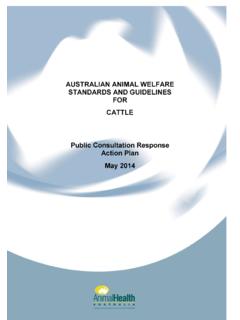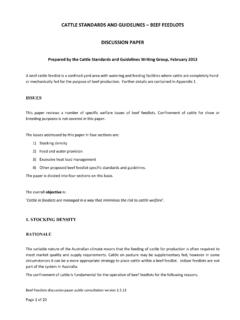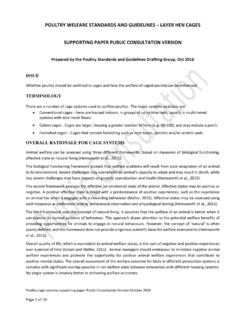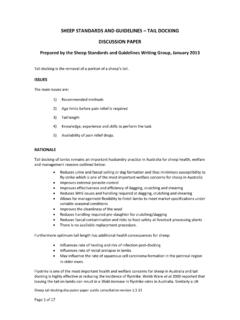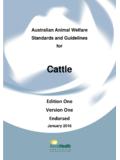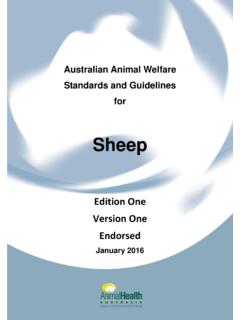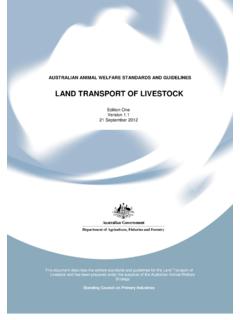Transcription of AUSTRALIAN ANIMAL WELFARE STRATEGY Development of ...
1 Page | 1 Development of AUSTRALIAN Standards and Guidelines for the WELFARE of Livestock BUSINESS plan (Revised February 2009) AUSTRALIAN ANIMAL WELFARE STRATEGY Development of AUSTRALIAN Standards and Guidelines for the WELFARE of Livestock Business plan [Revised February 2009] Introduction For the past 20 years, the WELFARE of livestock in Australia has been supported by a series of Model Codes of Practice for the WELFARE of Animals. As community values and expectations have changed, and our international trading partners have placed greater emphasis on livestock WELFARE , the usefulness and relevance of these Codes has been called into question, as has the process by which these Codes have been revised and developed.
2 To address these issues, Primary Industries Standing Committee (PISC) asked the AUSTRALIAN Government Department of Agriculture, Fisheries and Forestry (DAFF) to consider arrangements for reviewing and developing the Codes as a basis for Australia s future livestock WELFARE regulation. There is general agreement about the desirability of having national standards of livestock WELFARE that are consistently mandated and enforced in all states and territories. The need for improved processes, broader consultation and linkages to industry quality assurance programs also is generally acknowledged. There is broad consensus amongst all governments and peak industry bodies regarding a preferred process for revising and developing new WELFARE standards and guidelines.
3 Under the AUSTRALIAN ANIMAL WELFARE STRATEGY (AAWS) and ANIMAL Health Australia (AHA) management, the existing Model Codes of Practice (MCOP) will be re-written in a new format, to incorporate both the national WELFARE standards and industry guidelines for each species or enterprise ( saleyards, abattoirs). The task is to re-format each of the 22 existing MCOP into a document that combines AUSTRALIAN WELFARE Standards and Guidelines for that species or enterprise. It should be noted that several livestock industries have made significant progress in developing quality assurance programs that incorporate livestock WELFARE requirements.
4 The new standards and guidelines will be very relevant to the industry quality assurance programs and it is expected that there will be close alignment between these. It is noted that AHA does not have coverage of species such as buffalo, emus, ostriches, deer and feral animals, and would have limited ability to broker any funding arrangements for the re-formatting tasks. In the absence of an agreed cost-sharing formula for these species, it will be necessary to establish alternative funding arrangements. The actual review process could be contracted out to AHA or another organisation, to follow the agreed Development procedures.
5 This plan has been revised following the completion of the Development of the Land Transport Standards and Guidelines in September 2008 and incorporates recommendations made by the widely-representative Reference Group for that project. Page | 2 Development of AUSTRALIAN Standards and Guidelines for the WELFARE of Livestock BUSINESS plan (Revised February 2009) Vision The vision is to establish national livestock WELFARE standards that reflect contemporary scientific knowledge, competent ANIMAL husbandry and mainstream community expectations, and that these are maintained and enforced in a consistent, cost-effective manner.
6 Objective As a cornerstone of the AUSTRALIAN ANIMAL WELFARE STRATEGY , the national livestock WELFARE standards, with complementary guidelines, provide WELFARE outcomes that meet community and international expectations and reflect Australia s position as a leader in modern, sustainable and scientifically-based WELFARE practice. Strategic context AUSTRALIAN ANIMAL WELFARE StrategyAustralian Standards and Guidelines for the WELFARE of AnimalsState/Territory legislationRegulation/enforcement Extension Education TrainingAustralian WELFARE Standards WELFARE GuidelinesDelivery via co-regulated industry QA programsIMPROVED WELFARE OUTCOMES Page | 3 Development of AUSTRALIAN Standards and Guidelines for the WELFARE of Livestock BUSINESS plan (Revised February 2009) Existing WELFARE Codes The 22 existing Model Codes of Practice for the WELFARE of Animals are.
7 Animals at Saleyards (1991) Farmed Buffalo (1995) The Camel (2005) Cattle (2004) Land Transport of Cattle (1999) Farming of Deer (1991) Husbandry of Captive-Bred Emus (2006) Killing or Capture, Handling and Marketing of Feral Animals (1992) The Goat (1991) Land Transport of Horses (1997) Air Transport of Livestock (1986) Rail Transport of Livestock (1983) Road Transport of Livestock (1983) Sea Transport of Livestock (1987) Livestock at Slaughtering Establishments (2001) Farming of Ostrich (2003) Pigs (2nd Edition) (2008) Land Transport of Pigs (1998) Domestic Poultry (4th Edition) (2002) Land Transport of Poultry (2006) Intensive Husbandry of Rabbits (1991) Sheep (2nd edition) (2006) It is anticipated that six of these codes and one draft code will be made redundant by the Primary Industries Ministerial Council after endorsement of the standards and guidelines for the Land Transport of Livestock during 2009.
8 Land Transport of Poultry (2006) Land Transport of Cattle (1999) Land Transport of Horses (1997) Rail Transport of Livestock (1983) Road Transport of Livestock (1983) Land Transport of Pigs (1998) Land Transport of Sheep (draft) Two codes are under Development , and could be issued as standards and guidelines. These are: Horses Dogs (relevant for working dogs) Page | 4 Development of AUSTRALIAN Standards and Guidelines for the WELFARE of Livestock BUSINESS plan (Revised February 2009) Development process It is proposed that the existing Model Codes be prioritised and re-formatted as AUSTRALIAN Standards and Guidelines for the WELFARE of Livestock.
9 The three phases to Development prior to endorsement are: Development , public consultation and revision. Concurrent Development of the Regulation Impact Statement (RIS) is an important part of the decision-making process. Prioritisation 1. ANIMAL Health Australia (AHA) will work in consultation with the ANIMAL WELFARE Committee (AWC) and industry, to establish a flexible priority order for the re-formatting/review of the existing WELFARE Model Codes of Practice. Development 2. AHA will: confirm the budget and source(s) of funding with relevant parties establish a Writing Group (approximately 4-8 members), including appropriate industry representation, and convene the group.
10 3. In liaison with the AWC and relevant industry stakeholders, AHA in conjunction with a Writing Group, will for each project, arrange for: co-ordination of the Writing Group; preparation of a project plan terms of reference, deliverables, timelines, and preliminary budget; a preliminary outline of the proposed standards first draft; preparation of a technical issues paper as the basis for further decisions; selection of suitable candidates for the provision of research and consultation services, if necessary; preparation of an outline of appropriate communications STRATEGY ; invitations for a Standards Reference Group (SRG) with appropriate representation from key stakeholders, including all members of the AWC, RSPCA Australia, Animals Australia and other relevant organisations.
